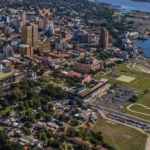Paraguay: an economy that can stand the heat
In the last five years, Paraguay’s economy grew at an annual average rate of around 5% - one of the highest in the region. This economic performance is especially remarkable considering it occurred in a rather volatile international environment, characterized by turbulent international financial markets, lower capital inflows to emerging economies and falling prices for metals and agricultural products. The Paraguayan economy was also affected by declining activity of some the region’s most significant trade partners.

What was it that allowed Paraguay to absorb these external shocks relatively well and continue growing? In our opinion, the development of an appropriate institutional framework for monetary and fiscal policies has been a fundamental factor. As a result, these policies have been managed with caution and discipline, consolidating an environment of macroeconomic stability and less uncertainty – vital to create sustained growth. Maintaining macroeconomic stability is essential to attract investment, and the significant positive externalities, higher productivity and overall well-being it brings.
In terms of monetary policy, the Central Bank of Paraguay (BCP) takes steps to keep inflation low, using a series of inflation targets that have anchored inflationary expectations. And for fiscal policy, the Fiscal Responsibility Law sets a deficit limit for the public sector, which has led to greater discipline in the management of public accounts. This has allowed Paraguay to consolidate its macroeconomic strengths - crucial to address the challenging international environment.
Transparent and predictable fiscal and monetary policies are internationally recognized as improving macroeconomic management. As a result, the Paraguayan government has sold a total of $2.38 billion (nearly 9.0% of GDP) of debt instruments in international financial markets since 2013. Paraguay also improved significantly in the macroeconomic environment pillar of the World Economic Forum’s Global Competitiveness Index, moving up from the 102nd position in 2006 to 60th in 2016. This put the country ahead of its MERCOSUR peers and it was the country showing the greatest progress from the entire Latin American region.
There are also several challenges that Paraguay needs to address in order to bolster medium term growth. According to the World Economic Forum, the country lags behind other countries in the region in important aspects such as provisions for physical infrastructure, innovation, higher education and training. It also needs to continue focusing on measures that diversify production and exports. All of these options require numerous details at the micro level as well as political support. Their implementation also poses serious institutional challenges and requires a highly qualified bureaucracy. Some of these suggestions are already in the process of being carried out, but it will take some time for them to have a notable impact on the economy.
Despite the challenges it will face, we maintain our positive outlook for the Paraguayan economy. The country has enormous potential in terms of natural resources and energy and good macroeconomic management. We therefore believe that it will continue to be one of the most dynamic economies in the region.